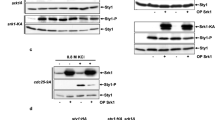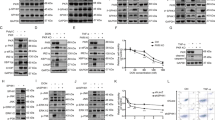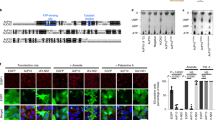Abstract
THE stress-activated protein kinases (SAPKs), which are identical to the c-Jun amino-terminal kinases (JNKs), are activated in response to a variety of cellular stresses, including DNA damage, heat shock or tumour-necrosis factor-α1,2. SAPK, a subfamily of the mitogen-activated protein (MAP) kinases, is a major protein kinase that phosphorylates c-Jun and other transcription factors2–5. SAPK phosphorylation of transcription factors is important in stress-activated signalling cascades1–6. Here we report that the protein p21WAF1/CIP1/Sdil, a DNA-damage-inducible cell-cycle inhibitor7–10, acts as an inhibitor of the SAPK group of mammalian MAP kinases. This highlights a new biochemical activity of p21, which may provide the first evidence for a non-enzymatic inhibitory protein for SAPK. We suggest that p21, by inhibiting SAPK, may participate in regulating signalling cascades that are activated by cellular stresses such as DNA damage.
This is a preview of subscription content, access via your institution
Access options
Subscribe to this journal
Receive 51 print issues and online access
$199.00 per year
only $3.90 per issue
Buy this article
- Purchase on SpringerLink
- Instant access to full article PDF
Prices may be subject to local taxes which are calculated during checkout
Similar content being viewed by others
References
Kyriakis, J. M. et al. Nature 369, 156–160 (1994).
Dérijard, B. et al. Cell 76, 1025–1037 (1994).
Gupta, S., Campbell, D., Dérijard, B. & Davis, R. J. Science 267, 389–393 (1995).
van Dam, H. et al. EMBO J. 14, 1798–1811 (1995).
Whitmarsh, A. J., Shore, P., Sharrocks, A. D. & Davis, R. J. Science 269, 403–407 (1995).
Davis, R. J. Trends biochem. Sci. 19, 470–473 (1994).
EI-Deiry, W. S. et al. Cell 75, 817–825 (1993).
Harper, J. W., Adami, G. R., Wei, N., Keyomarsi, K. & Elledge, S. J. Cell 75, 805–816 (1993).
Noda, A., Ning, Y., Venable, S. F., Pereira, S. O. & Smith, J. R. Expl Cell Res. 211, 90–98 (1994).
Xiong, Y. et al. Nature 366, 701–704 (1993).
Han, J., Lee, J.-D., Bibbs, L. & Ulevitch, R. J. Science 265, 808–811 (1994).
Chen, J., Jackson, P. K., Kirschner, M. W. & Dutta, A. Nature 374, 386–388 (1995).
Nakanishi, M., Robetorye, R., Adami, G. R., Pereira-Smith, O. M. & Smith, J. R. EMBO J. 14, 555–563 (1995).
Hunter, T. & Pines, J. Cell 79, 573–582 (1994).
Serrano, M., Hannon, G. J. & Beach, D. Nature 366, 704–707 (1993).
Fields, S. & Song, O. Nature 340, 245–247 (1989).
Sánchez, I. et al. Nature 372, 794–798 (1994).
Dérijard, B. et al. Science 267, 682–685 (1995).
Lin, A. et al. Science 268, 286–290 (1995).
Angel, P. & Karin, M. Biochim. biophys. Acta 1072, 129–157 (1991).
Herrlich, P., Ponta, H. & Rahmsdorf, H. J. Rev. Physiol. biochem. Pharmac. 119, 187–223 (1992).
Vogt, P. K. & Bos, T. S. Adv. Cancer Res. 55, 1–35 (1990).
Hilberg, F. & Wagner, E. F. Oncogene 7, 2371–2380 (1992).
Ham, J. et al. Neuron 14, 927–939 (1995).
Akashi, M. et al. J. biol. Chem. 270, 19181–19187 (1995).
Osawa, Y. et al. Biochem. biophys. Res. Commun. 216, 429–437 (1995).
Waga, S., Hannon, G. J., Beach, D. & Stillman, B. Nature 369, 574–578 (1994).
Seger, R. & Krebs, E. G. FASEB J. 9, 726–735 (1995).
Chen, C. & Okayama, H. Molec. cell. Biol. 7, 2745–2752 (1987).
Author information
Authors and Affiliations
Corresponding author
Rights and permissions
About this article
Cite this article
Shim, J., Lee, H., Park, J. et al. A non-enzymatic p21 protein inhibitor of stress-activated protein kinases. Nature 381, 804–807 (1996). https://doi.org/10.1038/381804a0
Received:
Accepted:
Issue Date:
DOI: https://doi.org/10.1038/381804a0
This article is cited by
-
Thr55 phosphorylation of p21 by MPK38/MELK ameliorates defects in glucose, lipid, and energy metabolism in diet-induced obese mice
Cell Death & Disease (2019)
-
JNKs function as CDK4-activating kinases by phosphorylating CDK4 and p21
Oncogene (2017)
-
The leukemia inhibitory factor (LIF) and p21 mediate the TGFβ tumor suppressive effects in human cutaneous melanoma
BMC Cancer (2015)
-
Biology of the cell cycle inhibitor p21CDKN1A: molecular mechanisms and relevance in chemical toxicology
Archives of Toxicology (2015)
-
Reactive oxygen species-mediated activation of the Akt/ASK1/p38 signaling cascade and p21Cip1 downregulation are required for shikonin-induced apoptosis
Apoptosis (2013)



